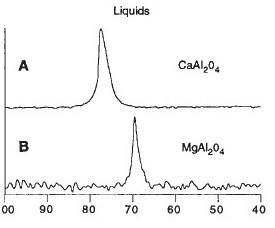Ask for a reprint
email :
* Give your email
1994
ACL
|
B.T.Poe, P.F.McMillan, B.Coté, D.Massiot, J.P.Coutures, 'Structure and dynamics in calcium aluminate liquids: high temperature 27Al NMR and raman spectroscopy', J. Am. Ceram. Soc. 77 1832-1838 (1994) doi:10.1111/j.1151-2916.1994.tb07058.x
27Al NMR spectra of CaO–Al2O3 liquids at 2500 K have been obtained using a recently developed technique that involves CO2 laser heating and sample levitation inside the NMR magnet. The spectra consist of single, narrow lines (100 to 200 Hz FWHM), indicating that rapid chemical exchange among molecular species occurs in the liquids. Isotropic chemical shifts vary linearly with composition, becoming more shielded with increasing Al2O3content. This is most likely due to an increase in the average nearest-neighbor coordination of Al, as the proportion of higher coordinate Al species (AlO5 and AlO6) has been observed to increase with alumina content in glasses along this join. This is also in agreement with ion dynamics simulations of liquids along the CaO–Al2O3 join, which show the average Al coordination to range from 4 at low alumina content to 5 for Al2O3liquid. Correlation times for 27Al spin–lattice relaxation estimated from the NMR line widths are in agreement with shear relaxation times determined from experimental viscosity measurements. This may indicate that oxygen exchange between neighboring aluminate polyhedra is a key component in the mechanism for viscous flow. Viscosities determined from oxygen ion diffusion coefficients via ion dynamics simulation agree well with extrapolation of experimental data, in further support of this. We have also obtained high-temperature Raman spectra of CaAl2O4 and Ca12Al14O33 glasses and liquids up to 1928 K. The liquid spectra contain structure similar to those of glasses, indicating that the aluminate liquids consist of AlOn polyhedral units on the vibrational time scale, rather than simple ionic species.
|

|